Depending on which account one reads about the life of Frederick Stump, he was considered a notorious “Indian killer” who was never brought to justice, or he was a feisty, German tavern owner and distiller of rum who successfully overcame insurmountable odds, more than once, when he found his life in shambles.
The controversy surrounding his life began on a cold, January evening in 1768 in what is now middle Pennsylvania on the edge of the wilderness land of the Six Nations (Iroquois) and Delaware Nations. Those settlers who lived on the border (“borderers”) were an agitation to the peace-loving Quaker communities which were found in much of the Pennsylvania area at that time. The borderers were also an agitation to the surrounding Nations because they had little regard for treaty agreements when these agreements conflicted with their way of life.
The following account of that wintry evening and the following day is attributed to Stump as he was relating it in the home of George Gabriel (account personalized):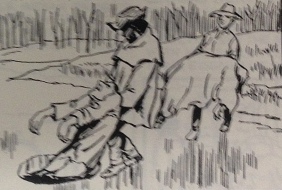
“White Mingo, Cornelius, John Campbell, Jones, and two women, came to my house and were “drunk and disorderly!” I tried to get them to leave and they refused. I was afraid I was putting myself in danger, so I killed them all. I then dragged their bodies to the creek, made a hole in the ice, and shoved their bodies into the water.
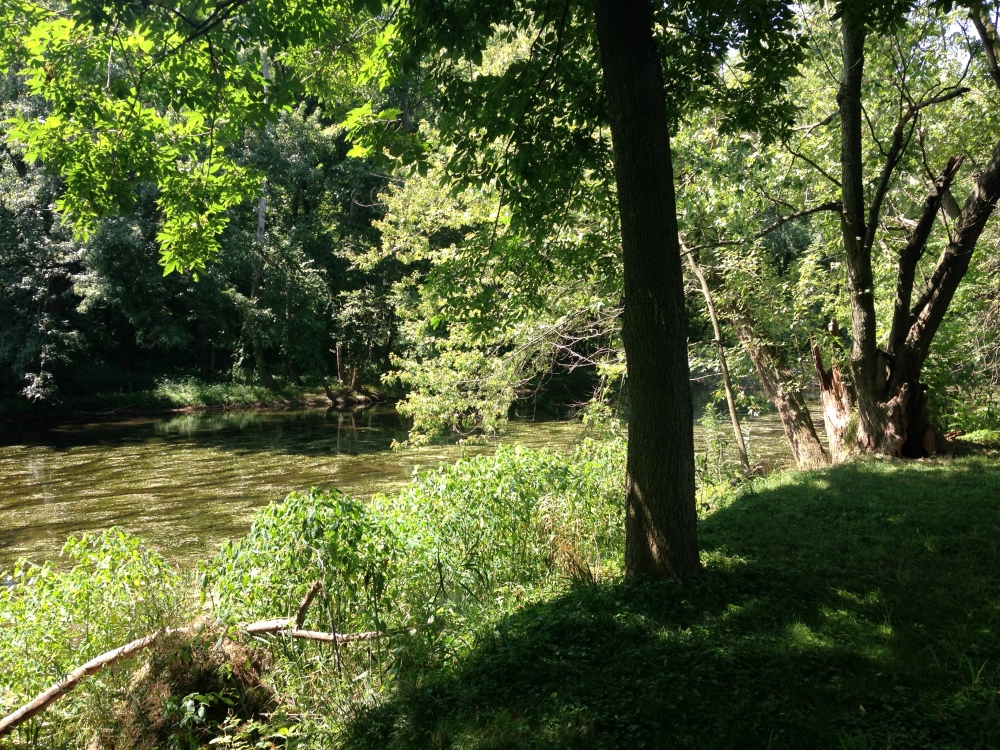
“I was afraid that news of this might be carried to the other members of the tribe, so the next day I took my servant, John Ironcutter, and we traveled some fourteen miles up the creek. There we found one woman and two girls and a child in two cabins. We killed them, put them in the cabins, and burned them.”
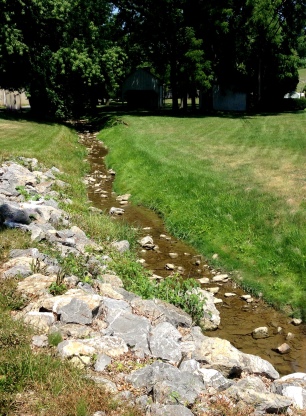
William Blythe, a member of the community who personally heard Stump’s account of the murders, immediately traveled to Philadelphia and, under oath, swore that he heard Frederick Stump admit to the murders when he had been in Gabriel’s home.
John Penn, the provincial governor, offered a reward of 200 British pounds for Stump and Ironcutter. Penn promised that they would be punished with death and that the leaders of the Six Nations and Delawares would be notified of what they had done.
Before the proclamation made its way back to the community, Stump and Ironcutter were swiftly arrested by a force of nineteen men led by the local British commander, William Patterson, of nearby Fort Augusta. After a defiant struggle, they were brought directly to the sheriff in the town of Carlisle in Cumberland County.
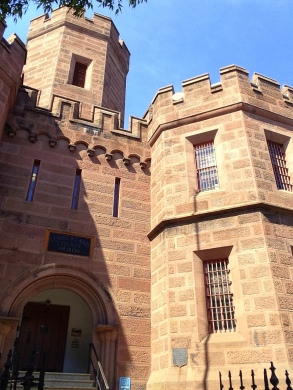
A letter was sent by the British commander to the Six Nations expressing condolences and restitution for the murders. A portion of the letter follows:
“The inhabitants of the province of Pennsylvania do disapprove of the said Stump and Ironcutter’s conduct; and as proof thereof, I have taken them prisoners, and will deliver them into the custody of officers, that will keep them ironed in prison for trial; and I make no doubt, as many of them as are guilty, will be condemned, and die for the offence.
“Brothers, I being truly sensible of the injury done you, I only add these few words, with my heart’s wish, that you may not rashly let go the fast hold of our chain of friendship, for the ill-conduct of one of our bad men.”
A reply from the Six Nations was magnanimous:
“Loving Brother: I am glad to hear from you. I understand that you are very much grieved, and that the tears run from your eyes. With both my hands I now wipe away those tears; and as I don’t doubt but your heart is disturbed, I remove all the sorrow from it, and make it easy, as it was before. I will now sit down and smoke my pipe. I have taken fast hold of the chain of friendship; and when I give it a pull, if I find my brothers, the English, have let it go, it will then be time for me to let go too, and take care of my family. There are four of my relatives murdered by Stump; and all I desire is, that he may suffer for his wicked action; I shall then think that people have the same goodness in their hearts as formerly, and intend to keep it there. As it was the evil spirit that caused Stump to commit this bad action, I blame none of my brothers, the English, but him.”
But before they could come to trial, Frederick Stump and John Ironcutter were rescued from jail by a large group of settlers, called the Paxton Boys*, who sympathized with Stump’s actions. In the past, local white settlers had been scalped and brutally murdered as well. The mob overpowered the sheriff and the jailor and released Stump and Ironcutter.
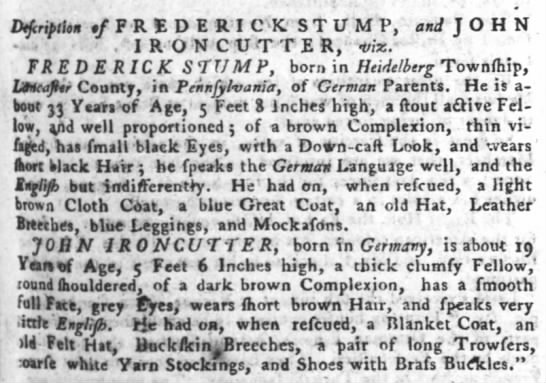
For a time it seems the Stumps lived near Fort Augusta at least until after Frederick, Jr. was born in 1769. Then he removed himself from the Pennsylvania country that had been their home and eventually settled near Augusta, Georgia. At the time, Frederick had a wife, Ann, a son, Jacob, 11, two daughters, Barbara, 7, and Anne, 6 and infant Frederick, Jr. It’s not certain if they went with him immediately because after the birth of Frederick, Jr., there is a seven year gap before his next child was born.
*It was said that Frederick Stump’s release from jail was accomplished by the “Paxton Boys” who were a group of pioneers frustrated with the lack of protection from Native American attacks during the Pontiac Wars of 1763-64.
The worst raid of Native Americans against white settlers in 1764 was by four Delaware who killed and scalped a school teacher and ten children. After these types of attacks, the Pennsylvania legislature, with Gov. Penn’s approval, reinstated the “scalp bounties” of the French and Indian War. These promoted attacks against Native American men and women above the age of ten.
The Iroquois were not part of the Pontiac War confederacy of tribes. They had made a previous “covenant chain” with the British. This is one reason the British were so quick to make amends with the Six Nations of Iroquois after the murders committed by Frederick Stump.
The Paxton Boys eventually turned vigilante and murdered Native Americans — some of whom were living peaceably among them. Benjamin Franklin accurately described the prevailing attitude in Pennsylvania surrounding the attacks of the Paxton Boys: “the Spirit of killing all Indians, Friends and Foes, [has] spread amazingly thro’ the whole Country.” (Benjamin Franklin to Richard Jackson, February 11, 1764, in The Papers of BenjaminFranklin) There seemed to be little difference between “self-defense” and “revenge” against Native Americans on the Pennsylvania frontier in the 1760’s. It is against this backdrop in which Frederick Stump committed the murders in 1768. He may well have been a Paxton Boy.
Read more about Frederick Stump in the post entitled “Fugitive, Fighter, Founder – Frederick Stump (Part 2).”
Frederick Stump is my 5th great grandfather. His daughter Anne is my 4th great grandmother who married Jonathan Guice.
Beautiful writing, Melinda.
Gr Paw Stump had different people writing about him with different viewpoints about what happened. This account seemed to be more official and accurate than the one from Seedtime on the Cumberland, I believe that title is right. I have one of those books if you need it. Any way you look at him he was a survivor. Love your style. Dad
I am a fifth granddaughter of Fredrick stump and Barbara I would like to visit the old homestead please reply
Hi Debbie I was at the Stump house and inn today! 4949 Buena Vista Pike, Nashville, Tennessee 37218. Super super to visit his home. There is a Tennessee Historical marker in front of the cabin. Nona Worton on facebook 🙂
The homestead in Pennsylvania is not marked or noted from what I can tell. My best estimates place it around the junction of Old 11 & 15 Road, and S Market St. south of Selinsgrove, Pennsylvania. The site of the massacre is in Middleburg, PA, west of the Glendale Cemetery. The street next to the cemetery runs along a creek and is called Stumps Avenue.
The Frederick Stump house north of Nashville, TN on Buena Vista Pike next to Briley Parkway is a private residence, so you would have to make arrangements with the owner to view it.
I visited the stump tavern and the owner was very nice I am looking for location where he is buried
Oh just saw this..you were there….yeah me too looking for the burial site …went to Spring HIlls Cemetery today and spoke to a man at the funeral home but he said no Stumps buried there. Went across the street to the National Vet Cemetery but the computer was down so could not look for Stump names. Still looking. Fredrick and Anna were my 5th greats too.
Hi Nona and Debbie: Nona when my hubby & I were in Nashville in 1993 the cemetery was by the log cabin on the east side of White’s Creek, the Inn/Tavern is on the West side. We took the long way around going north from the Tavern around & under the Briley Parkway back south by White’s Church and then turned down a dirt/gravel road. From the map that I emailed you it appears that the log home may have been moved or more houses have gone up in that area, so I don’t know if the gravesite is still there. There was a modern home and the grave yard was on the south side of the house and the log cabin was on the north side. It was very small, overgrown, no visible markers that I could see, and I believe there was a small fence around the grave yard and it could have been wrought iron? I also think I have information from an unknown source which states Anna Snavely Stump’s headstone was found at a home in Mississippi when the owners were doing some renovating. They found her stone as part of the cement slab under the house and only found it because they were elevating the home due to flooding. No one to my knowledge has figured out who wrote the note or how the stone got from Nashville to Mississippi. Were you able to find the log cabin? Talk to you soon, Allice
Do you have any info on Fredrick Jr. that was killed by the Harps near Bowling Green KY. I live on Stump Bluff Rd. and own the bluff where he was killed, on the Barren River. I would like to know where the house was located while he was living here.
Hello Ron: How exciting that you own the property where Frederick Stump Jr. was killed. I have a few documents regarding his death. A couple of newspaper articles, a story on the Harps, and some information on Frederick Sr. assist with the capture of one of the “brothers” who were really cousins, I believe. If you will email me privately at areyno5980@aol.com, I will gladly send you what I have.
Sincerely,
Allice Burns Reynolds
Allice,
I just ran across your reply and glad I did. I would very much like to see any information you have on Fredrick Jr. I don’t have anything that can be substantiated. Looking forward hearing from you.
Ron
Ron: My private email is areyno980@aol.com. If you will contact me there I will share all the documents I have on Frederick Stump, Jr. Allice Burns Reynolds
Ron, I only know that he was killed near Bowling Green by the Harp Bros.
I have photos of both the Tavern/Inn and the log cabin home. I would be happy to share and I would post them here if possible?
Allice Burns Reynolds
Please do! I have seen his tavern next to Briley Parkway and I have read about him going down to Batchez to find the Harps. I used to live in Bowling Green, but found out about Frederick Stump, Jr. after I moved away. I would love to see what info and photos you have. You may email them to me or post them on here if you can. My email is Ladyguice@bellsouth.net.
*Natchez
WOW! This is great stuff. Would like and info or pics. Fredrick Sr. and Ann are my ancestors. 6th great grand . vrnorth@gmail.com Really wold love to seen those places.
Hey cousins! Well, Frederick is a distant uncle, maybe great, great, great? My father had a really crazy story too, runs in the family I guess. Thanks so much for the wonderful story, truly amazing!
Hi Cousins: Always great to find new family!
Allice Burns Reynolds